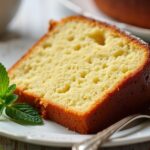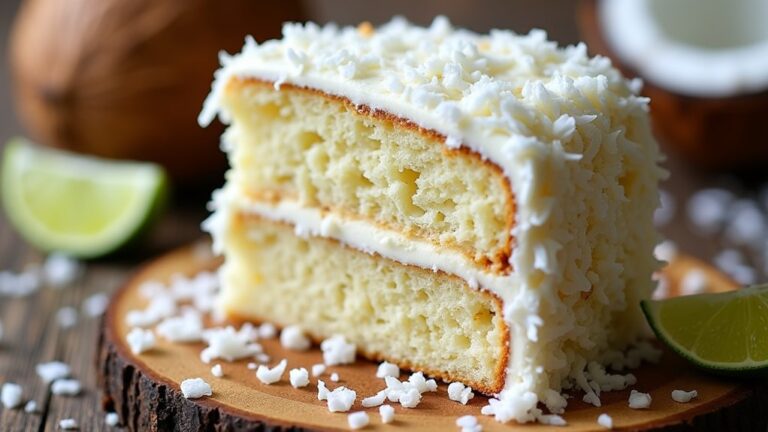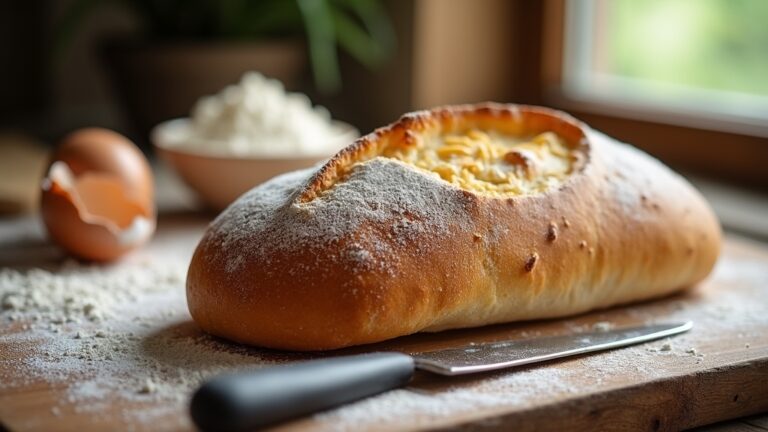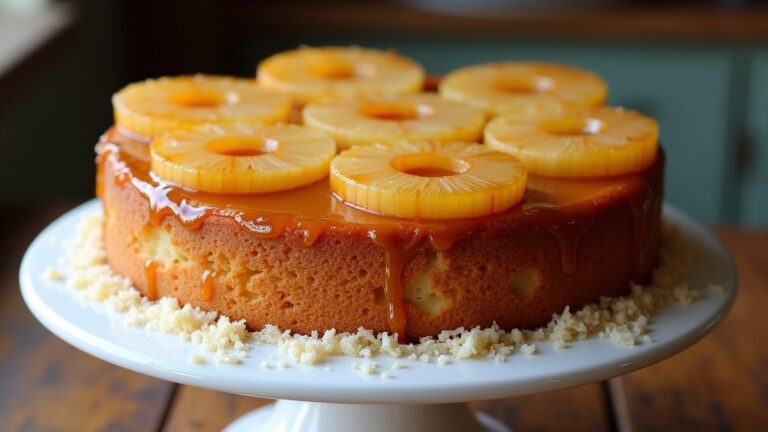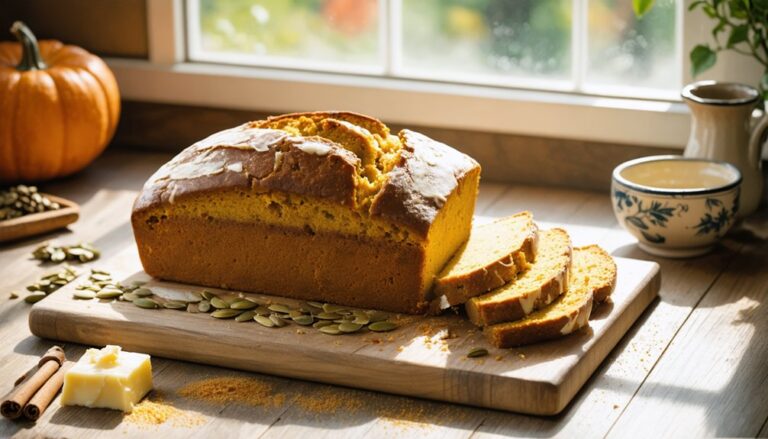Best Pound Cake Recipe
If you want the best pound cake recipe, I’ve got you covered! A classic pound cake needs equal parts of butter, sugar, eggs, and flour, creating a moist and rich dessert. Don’t forget to add your favorite flavors, like vanilla bean or lemon zest, to elevate the taste. Remember to properly mix your ingredients and fold the batter gently. This cake’s perfect for any occasion! Stick around, and I’ll share more tips and tricks for the perfect pound cake.
Contents
History
When I think about the history of pound cake, I’m reminded of its simple yet rich beginnings. The pound cake originates from a time when recipes were straightforward, with equal parts of butter, sugar, eggs, and flour—each weighing a pound. This balance not only created a dense, flavorful cake but also showcased the baking evolution over centuries. As time passed, bakers began experimenting with flavors and techniques, transforming this humble recipe into countless variations. Ingredients like vanilla, citrus zest, and even chocolate have been embraced, pushing the boundaries of traditional pound cake. It’s fascinating to see how this classic dessert has adapted, reflecting our ever-changing tastes while still honoring its roots. The journey of pound cake is truly a reflection of culinary innovation.
Recipe
Pound cake is a classic dessert known for its rich flavor and dense texture. Traditionally made with a pound each of flour, butter, sugar, and eggs, this cake has a delightful simplicity that allows the buttery essence to shine through. Its versatility means it can be enjoyed plain or adorned with fruits, glazes, or whipped cream, making it a favorite for many occasions—from family gatherings to elegant dinner parties.
To achieve the perfect pound cake, it is crucial to use quality ingredients and follow a few key techniques. Start by ensuring that your butter is at room temperature, which helps to create a light and fluffy batter when creamed with sugar. Additionally, be careful not to overmix the batter once the flour is added, as this can lead to a denser texture. With just a few simple steps, you can create a delicious pound cake that will impress your family and friends.
Ingredients:
- 1 cup unsalted butter, softened
- 2 cups granulated sugar
- 4 large eggs
- 3 cups all-purpose flour
- 1 teaspoon baking powder
- 1/2 teaspoon salt
- 1 cup whole milk
- 1 teaspoon vanilla extract
To cook the pound cake, preheat your oven to 350°F (175°C). Grease and flour a 10-inch bundt pan or loaf pan. In a large mixing bowl, cream the softened butter and granulated sugar together until light and fluffy. Add the eggs one at a time, mixing well after each addition. In a separate bowl, whisk together the flour, baking powder, and salt. Gradually add the dry ingredients to the butter mixture, alternating with the milk and vanilla extract, until everything is well combined. Pour the batter into the prepared pan and smooth the top. Bake for 60-70 minutes, or until a toothpick inserted into the center comes out clean. Allow the cake to cool in the pan for about 15 minutes before transferring it to a wire rack to cool completely.
When baking pound cake, remember that the quality of your ingredients can make a significant difference in flavor. For a richer taste, use high-quality butter and fresh eggs. If you’re looking to add a twist, consider incorporating citrus zest or almond extract for a unique flavor profile. Additionally, be sure to avoid overbaking, as this can dry out the cake; check for doneness a few minutes before the recommended time. Finally, allow the cake to rest overnight before slicing to enhance its flavor and texture. Enjoy your delicious homemade pound cake!
Cooking Steps
Let’s get started on the cooking steps that will lead us to a perfectly baked pound cake. First, I always preheat my oven to guarantee that it’s ready for that golden goodness. Then, I mix the dry ingredients together, creating a solid foundation for the delicious flavors to come.
Step 1. Preheat Your Oven
Before diving into mixing your ingredients, it’s important to preheat your oven to guarantee that your pound cake bakes evenly and rises beautifully. I usually set my oven temperature to 350°F, which is the sweet spot for achieving that perfect golden crust. While the oven warms up, I gather my baking equipment—don’t forget to line your loaf pan! This simple step prevents sticking and makes cleanup a breeze. As the heat builds, it creates a consistent baking environment, ensuring your cake’s texture is light and fluffy. Trust me, starting with a properly preheated oven is a game changer. You’ll be well on your way to a delightful pound cake that’ll impress anyone lucky enough to have a slice!
Step 2. Mix Dry Ingredients Together
With the oven preheating, it’s time to focus on mixing the dry ingredients together. I start by measuring flour, sugar, baking powder, and a pinch of salt, paying close attention to the dry ingredient ratios. This step is essential for achieving that perfect pound cake texture. I sift the flour and baking powder together, ensuring they’re well combined, which prevents lumps and promotes even baking. Using a whisk, I gently mix the sugar and salt into the dry ingredients, employing a circular motion that incorporates air, enhancing the cake’s fluffiness. By mastering these mixing techniques, I can set a solid foundation for a beautifully risen cake. It’s all about precision and a little creativity in the process!
Step 3. Add Wet Ingredients Gradually
As I prepare to add the wet ingredients, I can almost smell the deliciousness that’s about to unfold. It’s essential to master the wet ingredient ratios for a perfect pound cake. I start by slowly pouring in the melted butter, letting it blend seamlessly into the dry mix. Then, I add the eggs one at a time, allowing each to incorporate fully before the next. This gradual mixing technique guarantees the batter stays airy and light, vital for that tender crumb we all love. Next, I introduce the milk, drizzling it in while gently stirring. This careful approach not only prevents clumping but also enhances the cake’s flavor. Trust me; patience in this step pays off big time!
Step 4. Fold in the Batter
After ensuring the wet ingredients are perfectly blended into the dry mix, it’s time to fold in the batter. This step is essential for achieving that dreamy pound cake texture. I gently scoop the mixture from the bottom using a spatula, lifting and turning it over without stirring aggressively. This delicate folding technique helps maintain the batter consistency, ensuring it remains light and airy. I often find that a few gentle folds are all it takes to combine the ingredients seamlessly. Remember, the goal is to incorporate everything without deflating that precious air we’ve created. It’s a dance of precision, where patience pays off, leading to a pound cake that’s as innovative as it is classic.
Step 5. Bake Until Golden Brown
Slide your prepared cake pan into the oven, and let the magic begin. As the heat surrounds the batter, I can already envision that beautiful golden crust forming. I set my timer for about 60 minutes, but I keep an eye on it, using my favorite baking techniques to guarantee perfection. The aroma wafts through my kitchen, hinting at the deliciousness to come. Around the 50-minute mark, I start checking for doneness—my toothpick should come out clean, but I also look for that inviting golden hue. Once it’s reached that perfect color, I pull it out and let it rest. This waiting game is essential, as it allows the flavors to deepen and the texture to settle. Enjoy the anticipation!
Nutritional Guide
When it comes to enjoying a slice of pound cake, understanding its nutritional profile can help you savor it even more. A typical slice packs a delightful balance of flavors but also comes with a fair share of calories. By exploring ingredient substitutions, you can create a lighter version without sacrificing taste.
Here’s a quick nutritional guide:
| Nutrient | Amount per Slice |
|---|---|
| Caloric Content | 350 kcal |
| Total Fat | 15 g |
| Sugar | 20 g |
Final Thoughts
Although baking a pound cake might seem intimidating, I find that the joy of creating this classic dessert is well worth the effort. With baking tips like using room temperature ingredients and ensuring your oven is properly preheated, you’re already on the right track to success. Don’t hesitate to experiment with flavors—think vanilla bean, lemon zest, or almond extract for that innovative twist.
When it comes to serving suggestions, a simple dusting of powdered sugar or a drizzle of glaze can elevate your cake to new heights. You can even pair it with fresh berries and whipped cream for a stunning presentation. So, roll up your sleeves and plunge into this delightful baking adventure! Your taste buds will thank you.
Frequently Asked Questions
Can I Substitute Butter With Margarine in Pound Cake?
I’ve tried substituting butter with margarine in my baking. While the margarine flavor isn’t quite the same, it still yields a lovely texture. Just keep an eye on moisture; it can change the outcome slightly.
What’s the Best Way to Store Leftover Pound Cake?
Storing leftover pound cake’s like preserving a sweet memory. I freeze slices for later indulgence, wrapping them tightly in plastic. Alternatively, refrigerating slices keeps them moist, ready to delight whenever I crave a nostalgic bite.
How Can I Make My Pound Cake Gluten-Free?
To make my pound cake gluten-free, I substitute regular flour with gluten-free flour and add a pinch of baking soda for lift. It creates a delightful texture that’s just as satisfying and delicious!
Can I Add Fruit or Nuts to My Pound Cake?
I love experimenting with my pound cake. You can add fresh fruit options like berries or bananas, and nut varieties like walnuts or pecans for texture and flavor. It’s a delicious twist worth trying!
Why Is My Pound Cake Dense or Heavy?
My pound cake turned out dense because I didn’t get the ingredient ratios right and messed up the baking temperature. Adjusting those can transform your cake into a light, fluffy delight that’s simply irresistible!
Conclusion
As I savor the last bite of my freshly baked pound cake, I can’t help but wonder if its origins trace back to a time when families gathered around the hearth, sharing stories and laughter. Each slice, with its buttery crumb and golden crust, feels like a warm embrace. This cake isn’t just a treat; it’s a slice of history. So, let’s keep this tradition alive, baking memories one pound at a time, shall we?



